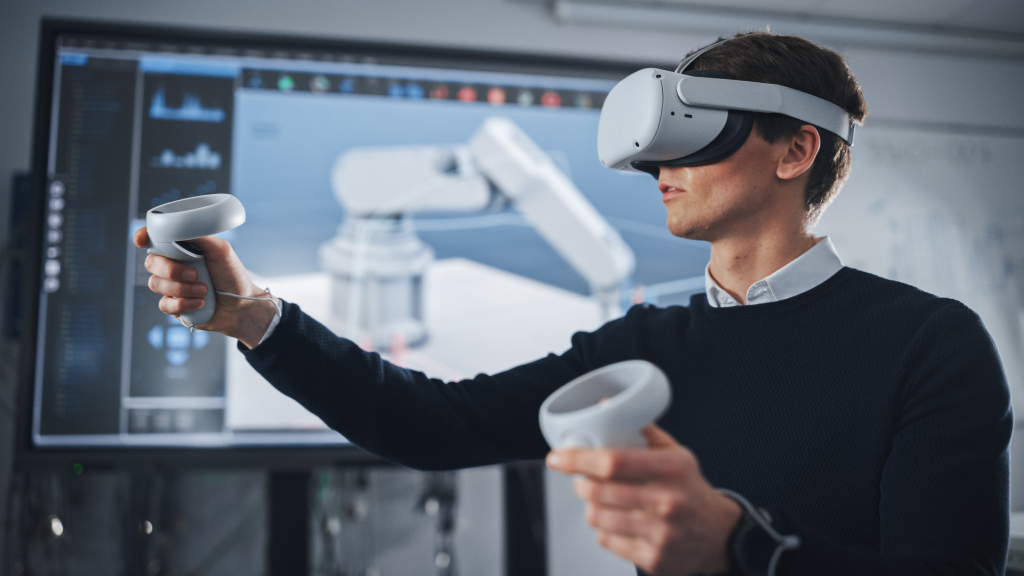Virtual Reality in Vocational Education: exploring opportunities for cognition, emotion and behavior
BeLEARN VR includes a variety of studies in different professions on the use of virtual reality – both in the form of computer-generated and of 360° video-based virtual reality – to support learning. Immersive or non-immersive modality of use are foreseen. In the former case the learning materials can be used on a personal computer, in the latter using a head-mounted display. Depending on the study, the cognitive, emotional, or behavioral component of learning will be investigated most.
BeLEARN VR is a project including several different studies with virtual reality (VR) as a common denominator. The whole project aims to shed light on the affordances and effects of immersive virtual reality (IVR) to support learning (in particular: procedural and emotional learning, e.g., stress management) in different fields of vocational education and training. Depending on the study, VR is considered in two possible implementations: (1) the classical, computer-generated, VR environment, and (2) VR environments and applications developed using 360° videos. In the latter case, we can make 360° video also interactive.
Depending on the study, different aspects of VR will be investigated, starting from the effects of immersion, sense of presence and interaction. At the moment, the following studies are ongoing:
- Creativity and IVR with draftsman architecture apprentices. We use GardenVR, a VR application to design gardens, to look at differences in creativity (trait, process, outcome) and motivation of draftsman apprentices by comparing a non-immersive (desktop) and an IVR conditions. The immersive use of GardenVR has already been explored previously, but no study could exploit its desktop version nor its direct comparison. The study will also be the occasion to discuss with teachers possible alternative uses of the application in the context of architectural design.
- Stress management with emergency medical technicians. We use 360° interactive videos to simulate rescues with ambulance and firemen teams interacting to save a patient wedged in a crashed car. The materials are used to train emergency medical technicians to observe specific details relevant to the professionals’ behavior. Using both self-reported and physiological measures, we want to test the hypothesis that a direct simulation in the field and an indirect simulation through viewing the scene via IVR elicit the same emotional arousal. This would be the premise to use IVR simulation to train emergency professionals.
- The flow of goods with chefs. We use 360° interactive videos to give apprentices the possibility to explore the whole flow of goods in a restaurant, since they have to be accepted and correctly stored with proper quality and hygiene checks to the final preparation, cooking and serving to the clients. 360° videos will allow to bring the workplace at school with a very high degree of realism and immersion; at the same time, this material can be a) enriched to include additional information and deepening, as a learning material; b) prepared with hidden interactive areas to be use for formative assessment, proposing different tasks. Also in this case, a contrast based on different degrees of immersion (desktop vs head-mounted display) will be performed as a first test. Then, alternative scenarios for in-class use will be designed and tested in collaboration with teachers.
- Receiving goods with logisticians. This case is very similar to the previous one, but for the fact that the profession is different and the content is limited to the first phase of receiving goods.
- Renting a flat for ABU. We use 360° interactive pictures to train apprentices on what they have to pay attention to when renting a flat. Also in this case, two different uses of the learning material can be foreseen, depending if it is adapted to be an instructional material or an assessment tool.
Depending on the study and the research question, we are using corresponding and appropriate methodologies. In general, we plan intervention studies and design experiments with teachers in a design-based research logic, based on participatory design and applying mixed-methods designs. When possible and appropriate, like in the case of the study with emergency medical technicians, beside self-reported and performance measures we will also integrate physiological measures (e.g., cortisol level, heart rate variability).
